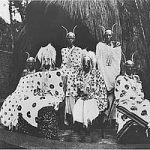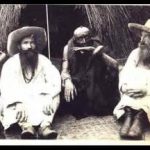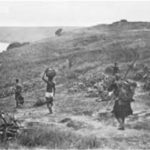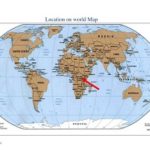VI. Herding, Hunting And Trading
HERDING

The Banyaremera herd goats, cattle, and sheep. The goats are the greatest in number and of the greatest economic importance. The cattle are more numerous than the sheep and occupy, without a doubt, the first place in social importance. Sheep are not numerous; their only importance is a religions one, and that is of no great significance, either.
The picture that various writers have drawn of herding in Ruanda is probably distorted. The social importance of cows and the social disregard shown towards goats have been reflected in the economic picture drawn by these authors. In fact, however, the cow plays only a remote economic role while goats are involved actively in the economy.
Only the strictly economic aspect of herding will be dealt with in this section. However, let it be said that “holdings” of cows were, still in the not too distant past, closely associated with “holdings” of land.
The cattle of Remera are generally herded by four specialists. Those people on the Hill who have a cow or a few cows bring them to one of these herders and, for the most part, leave them in his care. Of course, the situation is not as simple as this. It is highly complicated by the status of the owner of the cow and by the status of the cow itself. This fact is mentioned here, however, because it is from these four herds that an attempt to estimate the number of cattle on Remera was made.
It must be said that the Belgian administration has for a long time considered Ruanda overstocked and, to discourage any increase in the number of cattle, it has imposed a head-tax on all reproductive cattle. This amounted to 115 francs a year per head in 1960. It is difficult to obtain a tenable count ofthe herds under these conditions. To add to this inconvenience, the people of Remera feel that anyone who counts heads at all is bound to wish them harm.
The following count concerns the cattle on the Hill of Remera itself and does not include those animals owned by Banyaremera and herded outside of the Hill territory. Three herds were counted and recounted several times, giving a count of 31, 68, and 128 head, respectively. A fourth is roughly estimated at 40 head. This gives a total of 267 cattle. The official figure is 315 head of cattle according to the Rapport Annuel du Territoire de Kibungu, 1960. The official figure is also an estimate however, and may have been overestimated.
The pooling of these animals into herds not only liberates the cattle owners, who can then give their time to more lucrative work, but it also furnishes the specialists with means of fruitfully employing the time not spent in cultivating their fields. A contract is not made between owner and herder, however. If a herder agrees to take care of an individual’s cow, he takes it into his herd immediately and takes care of it. It is understood that he is entitled to some of its milk.After a year has passed, the owner comes to the herder with a gift of beer, neighbors are called in, and an appropriate recompense is discussed and agreed upon. This, nowadays, is generally 250 or 300 francs ($ 5.00 or $ 6.00).
It can be said that the use of cattle is threefold: that which is purely economic, that which records marriage transactions, and that which records the sealing of “feudal” relationships.
The economic role of cattle is very restricted indeed. Some possible economic uses of cattle can be eliminated from this discussion. Such is the case with their use as draft animals. To see a cow or bull draw a plow or cart is shocking to some Banyarwanda and ridiculous to others not for religious reasons, but because cattle are reserved for other “nobler” purposes. The efforts of the administration to introduce the plow and the use of cattle as draft animals were complete failures.
Consumption of meat, milk, and blood from cattle is not extensive. (The last not being used now that there are no famines.) The obvious reason, in Remera, is that there is less than one beast per household.
However, even at times when Remera did have a larger cattle population than it had at the time of this investigation, the shortage of beef and milk existed. This was because cattle were not bred for economic purposes. Only a very limited number of them could be disposed of for consumption; there was a minimum number of cattle below which the society could not fan for risk of losing its source of cattle entirely.
Even in the regions with the highest cattle population density and the lowest human density i.e., in the Mutara area, the aver-age number of cattle per household was 2.9 in 1952.Accordingto the distribution table given by Monsieur Bourgeois, the average number of cattle per household for the entire country would be 1.4. (However,this is an overestimation, since his distribution is given by area of population density and each area is averaged in as a unit, so that only a few households would have 2.9 head and many households would have 0.6 head.) With 1.4 head of cattle per household, cattle are bound to be slaughtered with parsimony and probably only as replacements are born.
In addition, to aggravate the shortage situation, the animals that are slaughtered do not produce a great amount of beef and have very little fat. According to Dr. D. Adamantidis, 40% to 48% of a slaughtered animal was usable for food.In the United States, the average prime steer dresses at over 60%.
Male calves and young bulls are killed for meat. When this occurs, those people of the Hill who want meat, come to fetch some. “They buy on credit” is the expression used to explain this: it is probable that it means that the “repay” later in kind or in work. On the other hand, the animal may be taken to the market nearby and slaughtered there. According to informants, this latter procedure is the most advantageous way of disposing of it. Meat is very expensively sold at the market — about $.40 a pound — when one considers the poor quality of the meat and the fact that a day’s wages are about $.20.
Although most of the herded cattle are female, milk production is very low. The best cows perhaps produce an average of one quart a day, during their period of lactation, which theoretically can be long, but in fact is constantly interrupted by pregnancy.The dry season also diminishes their output. In the herd of 31 cows, never more than four or five at a time gave milk. When there is milk, it has to be shared with the calf. Then, part goes to the herder and part to the owner. Both of these persons have a social obligation never to refuse milk to a person who comes with a request on behalf of a sick individualor a new mother. Milk can be further redistributed by the fact that it can be made into butter, which is a compulsory gift under certain circumstances, such as the first visit of a bride to her father’s home after her marriage. Those who have no cows ask it of the herders who may not refuse these requests. In the end, not much milk is left for either herder or owner and, although the children of some cow owners or cow herders might benefit from more milk than the average, on the whole, consumption is not great.
PASTURES
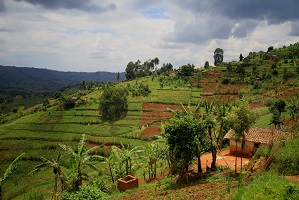
Amabangais communal pasture land. In theory, it seems that people from neighboring Hills can come to pasture their animals here, but in fact they seldom do so, if at all. Amabanga serves primarily for the pasturing of cows — goats and sheep being seldom brought here.
There are certain periods of the year during which, through common consent among the herders, the pasture lands are not used. During the dry season, for instance, when all of that area and the summit are submitted to grass fires, the cows are then pastured in the lowlands, preferably on, unbroken bottom lands above the papyrus swamps.
During the dry season,pasture is difficult to find for the cows. An important source of forage at this time is igisigati, the growth from the stubble of harvested sorghum. After the May or June sorghum harvest, the stalks, which are cut at the foot, are left in the ground. A second-growth starts from these stalks, which becomes forage for the cows. In traditional times, the Tutsi lords had an absolute right over the igisigatifrom the fields of people under their jurisdiction. In more recent times, the privilege to use igisigati has to be asked of the man who has cultivated the sorghum.
HUNTING

In Remera what little hunting is carried on takes place in the lowlands (igishanga). Most of the hunting is a communal affair, instituted for the express purpose of getting rid of the wild pigs and monkeys which destroy crops. These animals, together with a few bushbuck and antelope, servals, and, now rarely, buffalo and leopards, live in the unclaimed parts of the swamps.
The hunt is of the bush-beating type, and the men are armed with bow and arrow. There is a leader of the hunt whose post is permanent, and whose duty is to direct the battue. Most men consider these compulsory hunts a chore and use any pretext to excuse themselves,from attending them. If any game were killed, it would be distributed among the hunters as meat. Monkeys, servals, etc., are left to the dogs.
Thirty men were questioned on the subject of hunting. Ten of them have not hunted for Several years. All of the others have attended the last communal hunt because it is compulsory. Only two of these men said that they had killed game in the last twelve months. Neither of these kills occurred as a result of a communal hunt.
The first man said that he has killed an isha(bushbuck), and the other has killed an impongo(oryx antelope), on a hunt with other men, and also an impimbi(probably a duiker). The latter man is exceptional among the men of Remera in his love for the hunt. It may very well be that he had been hunting near or in a game preserve called the Kagera Park located not far from Remera.
MARKETING AND TRADE
Marketing and trade are of minor importance in Remera and may be considered as an extension of the rule of reciprocity that regulates reallocation of produce on the Hill itself.
Although there is a Wednesday market held at Kibungu, 7.5 miles away, the people of Remera only attend the closer (4.5 miles) market held every Sunday at Kabarondo.
Kabarondo is a “spontaneous” market, i.e., one that has sprung up of itself without stimulation from the administration. It came into being just after World War II, when, because of the world shortage of tin, the mines at nearby Rwinkwavu had a short-lived period of great activity. The number of workers there created an interesting market for the people of the nearby Hills. The mining activity had greatly dwindled at the time of this investigation, but the market remained. Very Little foodstuff is soldto Rwinkwavu by the people of Remera, but there is some activity in selling to people who have come to the market from the neigh-boring territory of Kigali.
A preliminary and superficial survey made at Remera in November 1960, before the crops were in, showed that many people had not been to market for months. In January 1961, a more extensive survey was made covering market attendance for several weeks in a row. It was estimated at that time that never more than 27% of the Remera households are represented at one time at the market — anyone from a household being counted as its representative. This, it seems, is not a particularly high percentage, especially if it is taken into consideration that:
(1)The survey was made just after harvest, at a time when Remera was considered to have had a good harvest.
(2)The neighboring territory of Kigali had had a drought and an important shortage of food had ensued there.
(3)The outpost of Kibungu was full “Of refugees from Central Ruanda, who had to be fed by the government from produce obtained at such markets,
However, aside from these circumstances, which may be considered extraordinary, it seems that most of the trade occurs among and between the peasants themselves. This may appear strange when it is obvious that all, buyers and sellers alike, are producers of the same goods. However, the apparent paradox disappears when one looks at these “exchanges” as an extension of the principle of reciprocity, which governs the reallocation of production among the members of a close-knit group. The following hypothetical example may serve as an illustration of this. A peasant from Remera, might, at a given time, be in need of a basket of sweet potatoes. Perhaps his own field is not yet producing now, although it would do so, in time. He would, then, obtain sweet potatoes from a neighbor or from his brother, and stand ‘ready to reciprocate in the future. However,it can and it does happen that his neighbor or brother is not in a position to furnish the desired item now. Then, the Remera peasant goes to market and buys sweet potatoes from a peasant of a nearby Hill. A week or so later, when his field of sweet potatoes has started to produce in abundance, he might return to market, but tins time with a basket of sweet potatoes which he sells (perhaps to the very man who was the seller in the first instance, but, of course, this is improbable), for the same price he himself paid. This idea of recuperation is one of the controlling factors of the price.
The market, in a way, is a sort of clearing house for produce that could not be reallocated effectively within the usual reciprocity group of an individual. In this sense, it is called here an extension of the reciprocity system. The price is very rigid and is fixed by authority of custom. Banana beer on the market place is 3 francs a bottle, whether sold in July and August — the peak production time — or in March and April — the low point in production. Certain items, such as tobacco and groundnuts winch do fluctuate in price between the season of relative abundance and the season of scarcity, change price within rigid limits.
Tobacco costs one franc for two leaves in times of abundance and two francs a leaf in the season of scarcity. Groundnuts are five francs a cupful in the good season and ten francs a cupful during the lean season. There are no in-between prices, and no variations in price within the same market place. Eggs are one-half franc each at Kabarondo and one franc each at Kibungu, regardless of season. Karl Polanyi has observed the existence of such rigidity in exchanges within “early society”He carries his analysis far beyond data whichwould apply here. Yet the existence of such an institution is significant, and is an indication of the non-commercial aspect of these exchanges. This end of exchange also takes place on the Hill itself, between people who are neither relatives nor close neighbors, which is a further indication that the market place is not essential for such trade.
However, for all that, it does not mean that there are no price fluctuations whatsoever. These do exist, and, seen from the outside, market prices may seem to fluctuate with world market prices.
These changes are probably due indirectly to the demands and regulations of the administration, which may be linked, for reasons extraneous to the society, to the world market. However, they are not due to the laws controlling a world market economy. These prices might have varied for a number of other reasons without changing the fundamental rule of reciprocity; the reason is un-important. The idea of making a profit is not involved, nor is the idea of living on one’s profits. Prices are not so much governed by the law of supply and demand as by the principle of reciprocity. The “price,” then, can vary sometimes because one can expect more from certain individuals than from others. In a social setting governed by reciprocity, those who have little give little and those who have, much are socially obligated to give much. As an illustration of this, a “redistributor” par excellence, the ex-chieftain, sought to insure some of his future subsistence, after he was voted out of office by the elections, by buying a field of standing manioc. This he did through a third partybecause he knew that, in the eyes of those who still thought of him as the chieftain, he was expected to pay much.
The converse is also true, i.e., what a Munyaremera is willing to pay is not governed by the value of the article or by the law of supply and demand, but by the amount of cash he — as the prospective buyer has at hand. This is why, what seem to be contradictions to our modem market economy minds exist in such an economy. On the one hand, a native demands more for his produce from the chieftain or from a European (who is, ipso facto, rich), but, on the other hand, may pay more than would a European for an item for which he has no means of attaching a cash value. Money itself has a value. However, in its use by the natives, even money has a value different from that ascribed it by a world economy. A loan of cash can bring 100% interest, not because of a combination of limited loan capital and poor risk, but because of a culturally standardized norm that a 100 franc bill should bring forth a 100 franc bill, just as a cow brings forth a cow, whether after a month or after a year. There are certain appropriate people with whom one can enter such a loan-interest relation, just as one can ubugwate a cow with them. On the otherhand, there are other persons to whom one has to give money or a cow, with returns calculated only on the reciprocity basis. These transactions involve no interest.
It is important to note that money currency itself is considered a mere commodity. No distinction whatsoever is made in the language between “to buy” and “to sell”: kugura. “To exchange” is kugurana, but even this concept is not clearly differentiated from the preceding one. This further underlines the fact that the Banyaremera think in terms of “participating in an ex-change,” when engaged in market type transactions.
Of course, the market is not entirely a closed system — or else money currency would not have been needed. Cash for clothing, machetes, hoes, salt, and a few luxuries is provided through income from the coffee crop and migrant labor.
In the same way that the market place can be said to be an extension of the reciprocity system, what “retail trade” goes on in Remera can also be said to be an extension of the same principle. Another ideal typical example is offered to illustrate the process. A Munyaremera might be in need of cash at a given moment, for instance during head-tax collection time. At such a time, he would find it difficult to obtain the money on a reciprocity basis from a neighbor or brother, since they would need the cash themselves. If his need is not so great as to cause him to leave immediately for Uganda, he might use the money he does have to buy a four-gallon can of kerosene, which he will resell in small quantities for profit. If this is not enough to complete the sum he needs, he might use his income from kerosene to buy palm oil, or matches, or cigarettes, or European-type beer, or salt, and resell these until he has accumulated the necessary sum. That is all. He never has stores of these things, and seldom has all of them during the time he is retailing, which is most often the length of time it takes him to sell the can of kerosene. Any greater need for money would most likely take him to Uganda.
He has sold the kerosene, the cigarettes, or the palm oil to people from whom he will buy these items, for the same price, at a time when they will be in the same situation, which prompted him to sell kerosene in the first place. Perhaps half of the households on the summit of Remera have at one time or another, carried on this sort of trade, perhaps never to engage in it again, or, at least, very sporadically. Moreover, such sales are not necessarily confined to the heads of households. A boy in need of a shirt to wear to school might buy a pack of cigarettes and retail them one at a time until he gets the thirty or forty francs he needs for a shirt. Depending on the amount of cash he had to begin with, a single pack can be enough for his needs. Otherwise, perhaps two or three packs would be sold cigarette by cigarette to give him the necessary amount. However, here again, the same process enters into play. It is easy to see how this process is essentially similar to that which operates at the level of the local market as described above.
The writer must, however, mention three or four individuals who are incipient merchants, in the sense that they do a bit more trading than others do, although none of them engages in it to such an extent that it takes the place of fillingtheir fields. Two of these specialize in selling European-type beer and matches. On the other hand, many more persons do no trading whatsoever. In addition to the coffee trade, which has already been discussed, there seems to be a regular stream of exchange with men from Tanganyika. These men come to Remera or to Kabarondo, bringing plaited sisal ropes used to tie goats. They exchange them for goatskins winch they take back to Tanganyika. It seems that they then sell the skins to Indian exporters. No attempt was made to estimate the extent of this trade nor its intensity beyond casual observation of the comings and goings of such individuals, both at Remera and at Kabarondo. Such observations yield the impression that the exchange is not abundant, but steady
https://uk.amateka.net/vi-herding-hunting-and-trading/https://uk.amateka.net/wp-content/uploads/2021/04/herding.jpghttps://uk.amateka.net/wp-content/uploads/2021/04/herding-150x150.jpgModel CitizenshipHERDING The Banyaremera herd goats, cattle, and sheep. The goats are the greatest in number and of the greatest economic importance. The cattle are more numerous than the sheep and occupy, without a doubt, the first place in social importance. Sheep are not numerous; their only importance is a religions...BarataBarata rpierre@ikaze.netAdministratorAMATEKA | HISTORY OF RWANDA

